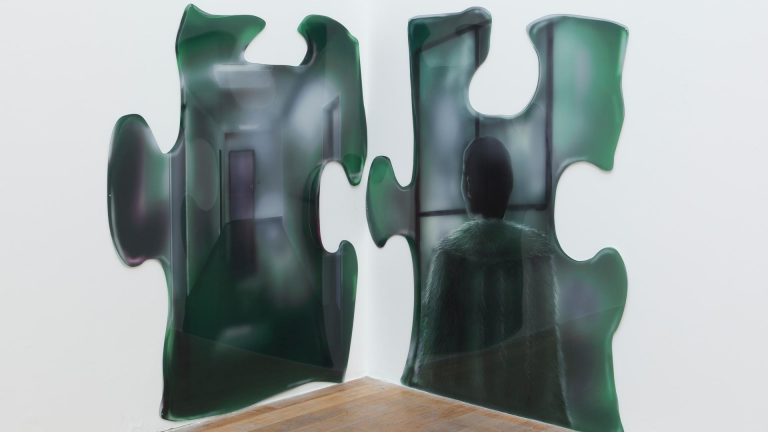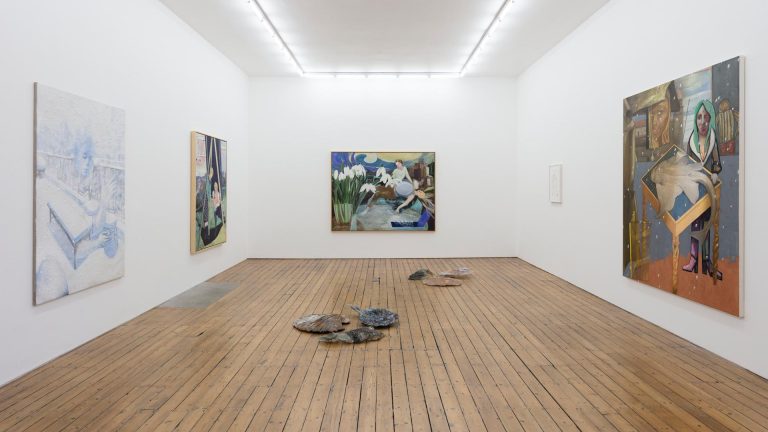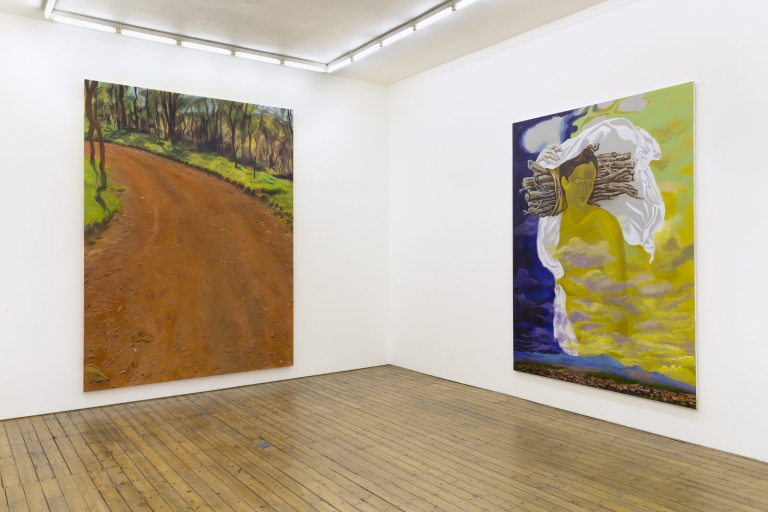Hubert Marot presents at ZÉRUÌ gallery in London a series of photographs, two installations and a printed book, all relating to a state that I would describe as circumspect. His practice is illusionistic: photographs are paintings, installations sculptures; but is also prudent, wise, meticulous. It comes from observation, from the careful gaze he takes around him. His work is also marked by a form of mysterious triviality and a penchant for antiquity, the imperishable, a race that he knows is lost in advance.
For him everything depends on the event held in suspension, a few moments that he cuts off arbitrarily and chooses, even pampers, once the impulse vanished. He practices photography, painting, installation in often fragilely established forms. He is also an artist who is part of a tradition of sceptic humor with regard to his works as well as his contemporary environment which is as if put under a bell, under a dome of spleen and slight paranoia. First there are his living or hypnagogic still-life photographs between a state of sleep and semi-awakening, photographed using a Canon AE-1film camera equipped with a small powerful flash to create harsh shadows like old police photographs. And it is true that his work is partly criminal documentation of minor cases.
On a linen canvas subjected to strong tensions, he mummifies his routine photographic corpse compositions. Thus, “one after the other; skin glue, gesso, undercoat and finally a photosensitive emulsion. The image is then projected on the wall with an enlarger and then finally developed using three silver chemistries: developer, stop bath, fixer. The pieces are then colorized with oil paint, sometimes very diluted for the flat areas (a sort of juice) and sometimes really “painted” in certain places.” The derisory thing, I was saying… the holiday accident of the fifth week of paid leave (Marot is French…) are transformed into Houellebecquian antique pieces, rouged to get through their purgatories and access a certain perpetuity. To the end-of-century morbid luxuriance of the French deviants of the 19th century, to the saturated and gargantuan compositions of the Flemish masters of the 17th century, he opposes a 21st century vision: placid, neurasthenic, relativistic but always linked to a form of sentimentality. The work is prepared as would a thanatologist who cleans and powders the body of the deceased. In the conceptual tradition of Frank Stella or even more recently Wade Guyton, his photographs are sleight of hand, hybridized mediums of an artist not yet recovered from everything but phlegmatic, as if imbued with a traditional depressive lucidity.
Thus, although random and partly due to chemical chance, the compositions proceed in the manner of vanitas by allegorical friction. Poire nasale et boules azurées du col de Vence opens the dance with its austere thistles, its curative overtones, and a life that spins, burns from the moment a match strikes; Gerberas de fin d’été et mouchoir honor the solar decline, the innocence of a flower produced in abundance, a door handle or erotic-spherical cylinder (garlic crush) which could have a completely different use leaning against fabric of crumpled cellulose. Psychotropic, hedonistic, deadly and lethal references abound and are often combined with their perfect inversions, candor, prettiness, happiness or delicacy. Parties tire and filthy niceties are interrupted or sent back to their cowardice in Éponge métallique et rose de rond-point; the thin film of a tangerine’s gland is threatened by a devil’s horn from a mountain lodge or by a discount mini-cactus in Cactus et cornes de chamois; a feverish double blister (a couple drifting apart?) attempts a temporary reunion in front of a still-life postcard overprinted with wisteria in Pont-Aven, the town of paaaainters… in Tondeuse et glycine de Pont-Aven; virginal and resilient winter flowers risk the guillotine in a tin can perhaps left by a tramp in a Parisian park in Perce-neiges du square Hector Berlioz et couteau; the artist’s murder weapon poses lasciviously in front of velvet, black vespers, alongside pompously livid plants in Akènes du quai Aulagnier et pistolet à peinture. We are in contact with pure contemporary vanitas, compositions of objects from garage sales, old towns, edges of over-loaded bathroom shelves, peripheral rave rooms, cheap talismans, trinkets, objects of predation and restoration which cut, shave, pierce, pull, sponge, rub. These vanities are like dark, brutal realities, tender truths too, because there is nothing more tender than compositions torn between these two polarities. With these works, death ceases waiting, the enslavement of waiting to be, vanity and disillusionment. Hubert Marot’s pieces are exorbitant and mutate with strange solitudes.
Strange and fleeting solitudes:
Let’s talk about his sculptures of inner tubes, carbon black tubes which intertwine into ouroboros, tubular knots which curve by twisting on rectangular and metallic rib cages. His two sculptures which order, overlook with their volumes; in fact manifest a thwarted authority which only exists in the present moment – only for those who believe in it -. His are air pump systems that are proudly, inflated like a fleeting stroke of power. This mechanical protection system invented in 1885 by Dunlop in Scotland evokes here more discomfort, a body subjected to external pressures. This anti-Allan Kaprow (Yard, 1961) where disordered tires saturated the exhibition and became a happening, child’s game, becomes here a symbol of hemorrhaging bodies, subjected to a struggle or even punishment. His glossy black tori, or geometric tubes closed on themselves, are all schematic versions of sculptures of Hercules triumphing over Cerberus, of Michelangelo’s rebellious or dying slaves, of a Laocoon struggling in the embrace of serpents but taken under the industrial aegis of Bruce Nauman or John Dogg (the fictitious artist created by Richard Prince and Colin de Land and fan of large cars). We are here in pastiche, steroidal and paradoxically evanescent sculpture. Its inflated forms and opportunistic volumes are shared between heroic overflow and a pathetic life, from sick sculptures under oxygen tubes to abandoned beaches and second-rate garages. The illusionism of fleeting solitudes prevails here too in his anabolic sculptures.
Added to his two series is a publication by MÖREL Books which emphasizes the loss of our current existences while still conceding a certain tenderness. In a riot of post-Y2K images fit dried thistles; monumental beach fairground bubbles; cyan blue BMW bodywork eaten away by wear and tear in the PACA region; Space Age or Marine industrial Chinese glassware; the silhouette of a man immobilized on the second floor of a Haussmann building surrounded by the red luminescent diodes of pedestrian crossing lights; inflatable plastic swimming pools with imperfect round-ness in which a white picnic chair sits; Seaside Tuk-Tuk stamped with a Lamborghini sticker; these photographs of the artist connote a world of emptiness, an apathetic reality where everything is celebrated and by the same token everything becomes disenchanted.
Life is a set of small, indefinitely repeated, often empty rites. What is also beautiful is this idea of considering the works of Hubert Marot from a humorous angle even though they are more tearful than they seem. Laughter and anguish are intrinsically mixed there, a tragic laughter, the kind that reminds us of being familiar with a family member, a friend, an object, a city or vacation spot for a given time. Yet everything dies.
_Pierre-Alexandre Mateos



































